
In The Bazaar of Love (The Selected Poetry of Amir Khusrau)
Book Specification
| Item Code: | NAF350 |
| Author: | Paul E. Losensky and Sunil Sharma |
| Publisher: | Penguin Books India Pvt. Ltd. |
| Language: | English |
| Edition: | 2013 |
| ISBN: | 9780143420798 |
| Pages: | 223 |
| Cover: | Paperback |
| Other Details | 8.0 Inch x 5.0 Inch |
| Weight | 190 gm |
Book Description
Amir Khusrau, one of the greatest poets of medieval India, helped forge a distinctive synthesis of Muslim and Hindu cultures. Written in Persian and Hindavi, his poems and Ghazals were appreciated across a cosmopolitan personate world that stretched from Turkey to Bengal. Having thrived for centuries, Khusrau’s poetry continues to be read and recited to this day.
In the Bazaar of Love is the first comprehensive selection of Khusrau’s work, offering new translations of mystical and romantic poems and fresh renditions of old favorites. Covering a wide range of genres and forms, it evokes the magic of one of the best-loved poets of the Indian subcontinent.
Paul E. Losensky is associate professor at Indian University, Bloomington, where he teaches translation studies, and Persian language and literature.
Sunil Shrama teaches Persian and Indian literatures at Boston University. He is the author of two books on Indo-Persian Poetry.
Amir Khusrau (1253-1325)-often also written as Khusraw or Khusro-was of the greatest poets of medieval India, writing in both Persian, the courtly language of Muslims of the sultanate Persian, and Hinddavi, the vernacular language of the Delhi area. Known as Tuti-yi Hind (Parrot of India) for his poetic eloquence and fluency in Persian, Amir Khusrau has stood as a major cultural icon in the history of Indian civilization for almost seven hundred years. He is especially remembered as the founder of the ‘Ganga-Jamni’ Hindustani culture which is a synthesis of Muslim and Hindu elements. He helped to give a distinctive character to Indian Islamic cultural traditions through his contributions to the fields of Indian classical music, Isamic mysticism (Sufism), south Asian Sufi music (Qawwali), and Persian literature. Significantly, he also contributed to the development of Hindavi, in which both modern Hindi and Urdu have their roots. Positioned at the juncture of two cultures, Amir Khusrau’s prodigious talents and prolific literary output make him one of the outstanding figures in Islamic, Indian, and indeed world cultural history.
Amir Khusrau’s legacy is far more widespread than people realize, from his vast corpus of Persian poetry that continues to be read in the modern Persian-Speaking world (Iran, Afghanistan and Tajikistan) to this day, to the devotional qawwalis that are performed and listened to in India, Pakistan, and beyond. He is rightly acknowledged as the best Indian poet to have written in Persian, and his influence on later Persian and Urdu literature was immense. In South Asia, he s revered for his contributions to music and mysticism but most people are familiar with only a small portion of his immense body of poetry and prose in Persian, or have no access to these works due to the language barrier. This which he lived, the entire area from anatoia (now Turkey) to India, no longer exists as a cultural continuum. Though the ruling elite of these lands was mainly Turksh by ethnicity, the language of high culture was Persian, with Arabic serving as the sacred language of religion. But Persian ceased to be a language of learning in the Indian subcontinent during the British colonial period, and with the fragmentation of the personate world by the forces of modern nationalism, many poets who form part of the Indian Persian heritage have suffered a similar fate, including the nineteenth century Ghalib, who wrote prodigiously in Persian as well as in Urdu. However, Amir Khusrau’s Hindavi poetry and Persian poetry on Sufi themes are still part of a living and dynamic tradition.
Amir Khusrau’s personality is shrouded in mystery and attempts to piece together his biography have difficulty resolving the apparent conflict between his professional life as a courier and his spiritual life as a mystic. As a courtier Khusrau would have had to overlook many morally dubious action and practices on the part of his patrons, for which he must have suffered some ethical conflict. Furthermore, while tradition credits Khusrau with a body of Hindavi poetry and the invention of several musical instruments, there is no written, documentary evidence to support this claim. Fortunately for us, there is quite a bit of biographical information and Amir Khusrau’s own writings and in numerous poetic and Sufi biographical narratives from throughout the medieval period. Although the information is not always reliable and the resulting picture of the poet seems one-dimensional or larger than life, it is more than we have for most other pre-modern poets. Getting to the real Amir Khusrau challenges us to sort through an overwhelming number and variety of original sources many unpublished, and to unravel the layers of cultural myth and legend that have shrouded his personality over the centuries.
There are some remarkable parallels between Amir Khusrau’s life and that of the renowned Sufi poet, Jalaluddin Rumi (d. 1273), who lived a generation or two before him. As a result of the Mongol incursion into central Asia Rumi fled west words with his family and ended up in Konya, in what is now Turkey. Similarly, a couple of decades later, Khusrau’s family moved eastwards and ended up in India. Both poets had their origins in the region of Balkh in present day Afghanistan. There are some salient differences in their biographies: Khusrau was born in India, to a Tukish father and Indian mother, and identified himself as an Indian; Rumi ethnically Iranian, was born near Balkh, far from Konya, the city where he was to settle. Also, Khusrau was deeply involved in court life, and most of his Persian writing, whether poetry or prose, is of a panegyric or historical nature, whereas Rumi was not a court poet and his output is entirely mystical. Thus, it is appropriate that khusrau is honoured with the title Amir (Prince) and Rumi with Maulana (Our Master). Nevertheless, just as Rumi had a deep attachment to his spiritual companion Shams, Khusrau was devoted to Nizamuddin Auliya. In poem 35 in our collection, Khusrau uses Rumi’s characteristic closing signature silence, as he rues his failure to turn fully to a life of religious devotion. Most importantly, both were poets of central Asian origin who deeply influenced the practice of Sufism in their respective part of the world through their emphasis on the mystical performance of music and dance, and the poetic language in which it was expressed. Both were immersed in the local cultures and wrote macaronic poetry, mixing Persian with local languages (Persian, Turkish, Greek and Arabic in Rumi’s case Persian and Hindavin in Amir Khusrau’s). Since both chose to write their poetry in Persian and authored a large body of ghazals on themes of love, there are many points of comparison from a literary point of view as well, although one must be sensitive to the different historical and social contexts in which they were active as poets.
| 1 | Achnowledgemets | ix |
| 2 | Introduction | xi |
| 3 | Ghazals | 1 |
| 4 | Other Poems | 87 |
| 5 | Miscellaneous Persian Poems | 89 |
| 6 | Macaronic and short persian poems | 98 |
| 7 | Hindavi poems | 105 |
| 8 | Narrative Poems | 117 |
| 9 | Selected Glossary | 157 |
| 10 | Bibliography | 159 |
| 11 | Index of Ghazals | 161 |













